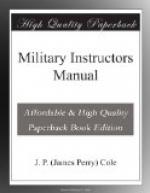VENEREAL diseases have already been touched upon.
TYPHOID FEVER is a germ disease and communicable. Vaccination is the first preventive; protection of water supply is the second; thorough disposal of wastes is a third; and sharp punishment for violation of sanitary regulations is a fourth. Habits of personal cleanliness will do much to prevent any such disease.
DYSENTERY is very common in field service, but may be prevented by same methods as for typhoid fever, save for vaccination; men suffering from this malady should be isolated, if possible, and utmost precaution taken to prevent spread of the disease.
MALARIA is a mosquito disease; get rid of mosquitoes and then you will get rid of the carrier of the germs. Quinine may act as a preventive. Cases should be isolated, if possible.
TONSILITIS AND COLDS may be combatted very effectively by proper precautions as to ventilation.
MEASLES.—Very important but little known; isolation recommended.
There are many other diseases concerning which the men should be instructed, but lack of space prevents further treatment of them. They should be taught the proper treatment of blistered feet, for they incapacitate a great many men; the chief causes are ill-fitting shoes and our old friend “uncleanliness.” Shoes are the most important article of clothing of the infantryman; each man should have one pair well broken in for marching, and two other pairs. Socks should be soft, smooth and without holes—also clean. Further steps for the prevention of blisters are; hardening of the skin by appropriate baths for the feet; soaping the feet; or adopting some other means of reducing the friction of the foot against the sock. Treatment—Wash the feet; open the blister at the lowest point, with a clean needle; dress with vaseline or other ointment and protect with adhesive plaster, care being taken not to shut out the air. Zinc oxide plaster is excellent. Sterilize a needle; thread it with a woolly thread and run it through blister, leaving ends projecting about one-half inch; this will act as a wick and dry up blister in short time.
FIRST AID.—Explain to the men the uses of the first aid packet and of the pouch carried by the Medical Corps. (This pouch is being replaced by web-belts with pockets.)
WOUNDS may be classed as ordinary cuts, inside wounds, lacerated, punctured and poisoned wounds. For ordinary minor wounds—iodine and exposure to the air are usually sufficient. War wounds are usually caused by something having an explosive effect and may be accompanied by hemorrhage, shock and even loss of function; they may be arterial or venous.
POISONED WOUNDS are of two sorts; external and internal.
DIAGNOSIS TAG.—This tag placed on a soldier shows wound, name, rank, regiment, treatment received, etc. This tag should be carefully read before further treatment is accorded.




